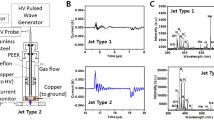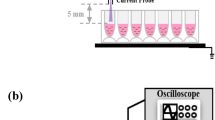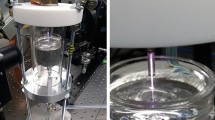Abstract
The tuning capacity of a novel excitation frequency controlled cold atmospheric pressure plasma jet in terms of reactive species density and its biological effect i.e., cell proliferation with changes in the excitation frequency was examined. The various reactive species produced were identified using optical emission spectroscopy. The physicochemical properties of the PTW (Plasma Treated Water) generated by the source were found to be almost linearly related with the time of treatment. For the presence of reactive species (H2O2, NO3− and NO2−), a comparison of plasma-treated water and cell culture medium at 11 kHz has been established. It has been observed that the variation in excitation frequency and treatment duration have important impact on cancer cell viability. In this regard, measuring the induced reactive species confirmed the strongest effect with CAP generated at 11 kHz frequency. Additionally, the 11 kHz frequency CAP produced the best biological outcome, among the different frequencies tested i.e., 11, 14, 22 and 26 kHz, as assessed by the reduction in proliferation of two different breast cancer cells (MCF-7 and MDA-MB-231). Further, the mechanistic aspects of CAP generated with 11 kHz frequency in inducing breast cancer cell death were investigated. The cancer cell death was rescued by co-treatment with N-acetyl cysteine, which indicated that the cell death effected by CAP is through the generation of reactive oxygen species. It has been shown that 11 kHz frequency CAP treatment induces excessive DNA damage and a prominent G1 phase cell cycle arrest and consequently cell death by apoptosis.













Similar content being viewed by others

References
Penkov OV, Khadem M, Lim WS, Kim DE (2015) A review of recent applications of atmospheric pressure plasma jets for materials processing. J Coat Technol Res 12:225–235
Domonkos M, Demo P, Kromka A (2020) Nanosphere lithography for structuring polycrystalline diamond films. Crystals 10:118
Li YF, Shimizu T, Zimmermann JL, Morfill GE (2012) Cold atmospheric plasma for surface disinfection. Plasma Process Polym 9:585
Laroussi M, LuX KeidarM (2017) Perspective: the physics, diagnostics, and applications of atmospheric pressure low temperature plasma sources used in plasma medicine. J Appl Phys 122:020901
Fridman G, Friedman G, Gutsol A, Shekhter AB, Vasilets VN, Fridman A (2008) Applied Plasma Medicine. Plasma Process Polym 5:503
Attri P, Yusupov M, Park JH, Lingamdinne LP, Koduru JR, Shiratani M, Choi EH, Bogaerts, (2016) A Mechanism and comparison of needle-type non-thermal direct and indirect atmospheric pressure plasma jets on the degradation of dyes. Sci Rep 6:34419
Smet C, Baka M, Dickenson A, Walsh JL, Valdramidis VP, Impe JFP (2017) Antimicrobial efficacy of cold atmospheric plasma for different intrinsic and extrinsic parameters. Plasma Process Polym 15:1700048
Kamionka J, Matthes R, Holtfreter B, Pink C, Schlüter R, Woedtke T, Kocher T, Jablonowski L (2022) Efficiency of cold atmospheric plasma, cleaning powders and their combination for biofilm removal on two different titanium implant surfaces. Clin Oral Investig 26(3):3179–3187
Xiang L, Xu X, Zhang S, Caia D, Dai X (2018) Cold atmospheric plasma conveys selectivity on triple negative breast cancer cells both in vitro and in vivo. Free Radical Biol Med 124:205–213
Keidar M (2015) Plasma for cancer treatment. Plasma Sources Sci Technol 24:033001
Winter J, Brandenburg R, Weltmann KD (2015) Atmospheric pressure plasma jets: an overview of devices and new directions. Plasma Sources Sci Technol 24:064001
Hoffmann C, Berganza C, Zhang J (2013) Cold Atmospheric Plasma: methods of production and application in dentistry and oncology. Med Gas Res 3:21
Bauer G, Sersenova D, Graves DB, Machala Z (2019) Cold Atmospheric plasma and plasma-Activated Medium trigger RONS-Based tumor cell Apoptosis. Sci Rep 9:14210
Mahdikia H, Shokri B, Majidzadeh AK (2021) The feasibility study of plasma-activated water as a physical therapy to induce apoptosis in melanoma cancer cells in-vitro. Iran J Pharm Res 20(3):337–350
Sersenová D, Machala Z, Repiská V, Gbelcová H (2021) Selective apoptotic effect of plasma activated liquids on human cancer cell lines. Molecules 26(14):4254
Cancer (2021) https://www.who.int/news-room/fact-sheets/detail/cancer (accessed October 2021)
Ferlay J, Ervik M, Lam F, Colombet M, Mery L, Piñeros M (2020) Global Cancer Observatory: Cancer Today. Lyon: International Agency for Research on Cancer; (https://gco.iarc.fr/today, accessed February 2021).
IARC (2021) Cancer fact sheets, https://gco.iarc.fr/today/data/factsheets/cancers/39-All-cancers-fact-sheet.pdf (accessed October 2021)
Carelle N, Piotto E, Bellanger A, Germanaud J, Thuillier A, Khayat D (2002) Changing patient perceptions of the side effects of cancer chemotherapy. Cancer 95(1):155–163
Mansoori B, Mohammadi A, Davudian S, Shirjang S, Behzad B (2017) The different mechanisms of cancer drug resistance: a brief review. Adv Pharm Bull 7(3):339–348
Longley DB, Johnston PG (2005) Molecular mechanisms of drug resistance. J Pathol 205(2):275–292
Yan D, Sherman JH, Keidar M (2017) Cold atmospheric plasma, a novel promising anti-cancer treatment modality. Oncotarget 8(9):15977–15995
Koritzer J, Boxhammer V, Schafer A, Shimizu T, Klampfl TG, Li YF, Welz C, Schwenk-Zieger S, Morfill GE, Zimmermann JL, Schlegel J (2013) Restoration of sensitivity in chemo-resistant glioma cells by cold atmospheric plasma. PLoS ONE 8(5):e64498
Ishaq M, Han ZJ, Kumar S, Evans MD, Ostrikov KK (2015) Atmospheric-pressure plasma-and TRAIL-induced apoptosis in TRAIL-resistant colorectal cancer cells. Plasma Processes Polym 12(6):574–582
Wang M, Holmes B, Cheng X, Zhu W, Keidar M, Zhang LG (2013) Cold atmospheric plasma for selectively ablating metastatic breast cancer cells. PLoS ONE 8(9):e73741
Preston RG, Ogawa T, Uemura M, Shumulinsky G, Valle BL, Pirini F (2014) Cold atmospheric plasma treatment selectively targets head and neck squamous cell carcinoma cells. Int J Mol Med 34(4):941–946
Saadati F, Mahdikia H, Abbaszadeh HA, Abdollahifar MA, Khoramgah MS, Shokri B (2018) Comparison of Direct and Indirect cold atmospheric-pressure plasma methods in the B16F10 melanoma cancer cells treatment. Sci Rep 8(1):7689
Akishev YS, Balakirev AA, Grushin ME, Karalnik VB, Medvedev MA, PetryakovAV TNI (2020) Pin-to-plane self-pulsing discharge in transversal airflow: interaction with a substrate of plasma filaments blown out from the discharge zone. Plasma Sources Sci Technol 29:045012
Fridman G, Peddinghaus M, Ayan H, Fridman A, Balasubramanian M, Gutsol A, Brooks A, Friedman G (2006) Blood coagulation and living tissue sterilization by floating-electrode dielectric barrier discharge in air. Plasma Chem Plasma Process 26:425–442
Stoffels E, Flikweert AJ, Stoffels WW, Kroesen GMW (2002) Plasma needle: a non-destructive atmospheric plasma source for fine surface treatment of (bio)materials. Plasma Sources Sci Technol 11:383–388
Park J, Henins I, Herrmann HW, Selwyn GS, Jeong JY, Hicks RF, Shim D, Chang CS (2000) An atmospheric pressure plasma source. Appl Phys Lett 76(3):288–290
Tiwari N, Misra VC, Ghorui S (2022) Study of unique aspects of oxidative-nitrosative environment in a radio frequency cold plasma device. Vacuum 205:111407
Ghorui S (2022) A novel excitation frequency controlled cold atmospheric pressure plasma device and its unique discharge behaviour. Pramana J Phys 96:147
Misra VC, Tiwari N, Ghorui S (2022) Characterization and investigation of the unique plasma behavior caused by variable driving frequencies in the formation of cold atmospheric plasma. Curr Appl Phys 41:92–99
Bellare GP, Patro BS (2022) Resveratrol sensitizes breast cancer to PARP inhibitor, talazoparib through dual inhibition of AKT and autophagy flux. Biochem Pharma 199:115024
Bellare GP, Saha B, Patro BS (2021) Targeting autophagy reverses de novo resistance in homologous recombination repair proficient breast cancers to PARP inhibition. Br J Cancer 124:1260–1274
Nie D, Wang W, Yang D, Shi H, Huo Y, Dai L (2011) Opticalstudy of diffuse bi-directional nanosecond pulsed dielectric barrier discharge in nitrogen, Spectrochim. Acta Part A 79:1896–1903
Elsawah M, Ghafar HHA, Morgan NN, Hassaballa S, Samir A, Elakshar FF, Garamoon AA (2012) Corona discharge with electrospraying system for phenol removal from water. IEEE Trans Plasma Sci 40:29–33
Parvulescu VI, Magureanu M, Lukes P (2012) Plasma Chemistry and Catalysis in Gases and Liquids, Wiley, Hoboken, NJ
Hu X, Zhang Y, Wu RA, Liao X, Liu D, Cullen PJ, Zhou RW, Ding T (2022) Diagnostic analysis of reactive species in plasma-activated water (PAW): current advances and outlooks. J Phys D Appl Phys 55:023002
Svarnas P, Poupouzas M, Papalexopoulou K, Kalaitzopoulou E, Skipitari M, Papadea P, Varemmenou A, Giannakopoulos E, Georgiou CD, Georga S, Krontiras C (2022) Water modification by cold plasma jet with respect to physical and chemical properties. Appl Sci 12:11950
Xiang QS, Zhang R, Fan LM, Ma YF, Wu D, Li K, Bai YF (2020) Microbial inactivation and quality of grapes treated by plasma-activated water combined with mild heat LWT-Food Sci. Technol 126:109336
Radi R (2018) Oxygen radicals, nitric oxide, and peroxynitrite: Redoxpathways in molecular medicine. PNAS 115(23):5839–5848
Yan D, Jonathan HS, Xiaoqian C, Ratovitski E, Canady J, Keidar M (2014) Controlling plasma stimulated media in cancer treatment application. Appl Phys Lett 105:224101
Tresp H, Malte UH, Weltmann KD, Reuter S (2013) Effects of atmosphere composition and liquid type on plasma-generated reactive species in biologically relevant solutions. Plasma Med 3(1–2):45–55
Boehm D, Heslin C, Cullen PJ, Bourke P (2016) Cytotoxic and mutagenic potential of solutions exposed to cold atmospheric plasma. Sci Rep 6:21464
Hanahan D, Weinberg RA (2011) Hallmarks of cancer: the next generation. Cell 144:646–674
Dai X, Cheng H, Bai Z, Li J (2017) Breast cancer cell line classification and its relevance with breast tumor subtyping. J Cancer 8(16):3131–3141
Lee S, Lee H, Jeong D, Ham J, Park S, Choi EH, Kim SJ (2017) Cold atmospheric plasma restores tamoxifen sensitivity in resistant MCF-7 breast cancer cell. Free Radic Biol Med 110:280–290
Zhitkovich A (2019) N-acetylcysteine: antioxidant, aldehyde scavenger, and more. Chem Res Toxicol 32:1318–1319
Yan D, Talbot A, Nourmohammadi N, Cheng X, Canady J, Sherman J, Keidar M (2015) Principles of using cold atmospheric plasma stimulated media for cancer treatment. Sci Rep 5:18339
Yang XH, Sladek TL, Liu X, Butler BR, Froelich CJ, Thor AD (2001) Reconstitution of caspase 3 sensitizes MCF-7 breast cancer cells to doxorubicin- and etoposide-induced apoptosis. Cancer Res 61:348–354
Häcker G (2000) The morphology of apoptosis. Cell Tissue Res 301:5–17
Murad H, Hawat M, Ekhtiar A, AlJapawe A, Abbas A, Darwish H, Sbenati O, Ghannam A (2016) Induction of G1-phase cell cycle arrest and apoptosis pathway in MDA-MB-231 human breast cancer cells by sulfated polysaccharide extracted from Laurencia papillosa. Cancer Cell Int 16:39
Chen J (2016) The cell-cycle arrest and apoptotic functions of p53 in tumor initiation and progression. Cold Spring Harb Perspect Med 6(3):a026104
Hustedt N, Durocher D (2017) The control of DNA repair by the cell cycle. Nat Cell Biol 19:1–9
Mah LJ, Osta AE, Karagiannis TC (2010) gammaH2AX: a sensitive molecular marker of DNA damage and repair. Leukemia 24:679–686
Panier S, Boulton SJ (2014) Double-strand break repair: 53BP1 comes into focus. Nat Rev Mol Cell Biol 15:7–18
Acknowledgements
Authors wish to acknowledge valuable helps received from Mr Tushar Hire (L&PTD, BARC) during EFCAP operation. Authors thank Head, L&PTD, GD, BTDG and GD, BSG for their kind support.
Author information
Authors and Affiliations
Corresponding author
Additional information
Publisher's Note
Springer Nature remains neutral with regard to jurisdictional claims in published maps and institutional affiliations.
Supplementary Information
Below is the link to the electronic supplementary material.
Rights and permissions
Springer Nature or its licensor (e.g. a society or other partner) holds exclusive rights to this article under a publishing agreement with the author(s) or other rightsholder(s); author self-archiving of the accepted manuscript version of this article is solely governed by the terms of such publishing agreement and applicable law.
About this article
Cite this article
Chaturvedi Misra, V., Pai B, G., Tiwari, N. et al. Excitation Frequency Effect on Breast Cancer Cell Death by Atmospheric Pressure Cold Plasma. Plasma Chem Plasma Process 43, 467–490 (2023). https://doi.org/10.1007/s11090-023-10312-3
Received:
Accepted:
Published:
Issue Date:
DOI: https://doi.org/10.1007/s11090-023-10312-3



